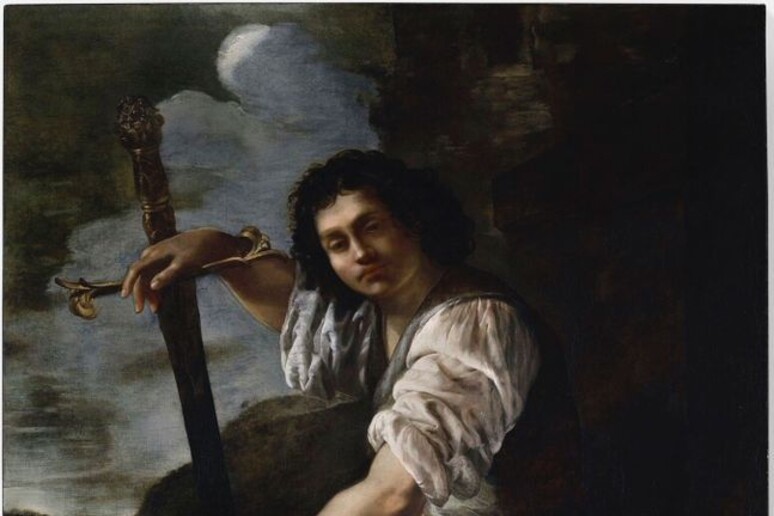A new Artemisia Gentileschi
painting has been 'discovered' in London after long being
attributed to one of her father's students.
The David and Goliath (1639), hitherto attributed to Giovanni
Francesco Guerrieri, has now been recognised as on the official
canon of the queen of the Italian Baroque after years of dispute
among experts.
Art historian Simon Gillespie found Artemisia's signature on
David's sword after a recent restoration of the work.
This summer the National Gallery will host the UK's first
monographic show on Gentileschi, from April 4 to July 26.
Long underrated because of an alleged scandal linked to her
rape by an older painter, Artemisia is now considered one of the
most accomplished seventeenth-century artists working in the
dramatic style of Caravaggio.
In an era when women had few opportunities to pursue artistic
training or work as professional artists, Artemisia was the
first woman to become a member of the Accademia di Arte del
Disegno in Florence and had an international clientele.
Artemisia specialized in scenes of female heroines and
stories centered on women from myths, allegories, and the Bible,
including victims, suicides, and warriors.
Some of her best known subjects are Susanna and the Elders
(particularly the 1610 version in Pommersfelden) and Judith
Slaying Holofernes (her 1614-1620 version is in the Uffizi
gallery) and Judith and Her Maidservant (her version of 1625 at
the Detroit Institute of Arts).
Artemisia was known for being able to depict the female
figure with great naturalism, and her skill in handling color to
express dimension and drama.
The story of her rape by late Mannerist painter Agostino
Tassi as a young woman and her participation in the trial of her
rapist long overshadowed her achievements as an artist.
For many years, she was regarded as a curiosity.
Her life and art have been reexamined by scholars in the 20th
century, and she is now regarded as one of the most progressive
and expressive painters of her generation.
The Art Newspaper said last week that ahead of the first
major UK exhibition of Gentileschi's work, a London conservation
studio has unveiled a painting newly attributed to this
best-known female artist of the Italian Baroque.
The large oil on canvas depicts David and Goliath, a favourite
Biblical subject for both Artemisia (1593-around 1654) and her
father, Orazio Gentileschi (1563-1639). When the work was sold
at Sotheby's in 1975, it was attributed to Giovanni Francesco
Guerrieri (1589-1655), a student of Orazio. However, by the time
it resurfaced in 2018 at Hampel Fine Art Auctions in Munich,
Artemisia had entered the art historical canon, and the work
came under scrutiny from scholars and dealers. It was
reattributed at the eleventh hour to Artemisia, selling for
€104,000 to a UK-based collector who wishes to remain anonymous.
He engaged the private conservator Simon Gillespie to restore
the painting in London-the city in which the work is thought to
have been painted in the late 1630s. After periods working in
Rome, Florence, Venice and Naples, Artemisia stayed in the
English capital in 1639, possibly assisting her elderly father
to complete a series of allegorical ceiling paintings for the
Queen's House in Greenwich (later moved to Marlborough House).
Gillespie and the Italian scholar Gianni Papi, a Caravaggio
and Gentileschi specialist, back the new attribution of David
and Goliath to Artemisia in the latest issue of the Burlington
Magazine. As long ago as 1996, Papi writes, he thought the
painting "seemed characteristic of Gentileschi in its atmosphere
and especially in the sinuous figure of David", based on the
single black-and-white photograph available at the time.
Now, having studied the work in the conservation studio, Papi
says cleaning has revealed an original colour palette consistent
with Artemisia's work, for example in the brightened sky and
David's golden ochre cloak. Other details that suggest her hand
include David's sleeve, the play of light across his face and
the barren landscape. Papi identifies the work with an
18th-century account by the art historian and politician Horace
Walpole, who wrote: "King Charles [I of England] had several of
[Artemisia Gentileschi's] works. Her best was David with the
head of Goliath."
Gillespie's restoration also uncovered the faint signature
"Artemisia" along the blade of David's sword. The inscription
includes the digits "16-", presumably the traces of a date that
can no longer be read, Gillespie writes in his technical report
for the magazine. The discovery is "confirmation of the
painting's autograph status", according to Papi.
ALL RIGHTS RESERVED © Copyright ANSA











